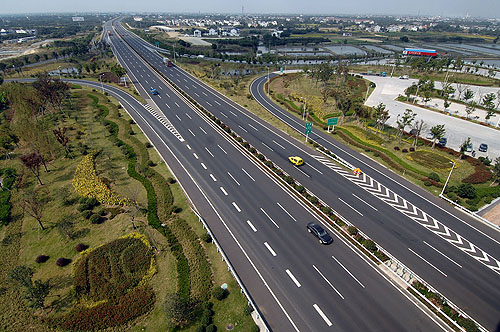|
 |
|
FAST TRACK: The integration plan for the Yangtze River Delta includes building a fast regional transportation network (HAN YUQING) |
The newly integrated local medical insurance system, which until now has been impossible to put in place under current circumstances, will become a reality in the Yangtze River Delta region.
Related local government departments in the area are working on the new system as part of a larger plan for regional economic integration. Once it is created, the integrated medical insurance system will have big advantages for people who live in the region and frequently move to wherever they find work. They will no longer have to live in the same place to receive reimbursements for their medical expenses as they do now. In the future, once they register for medical insurance in one place, they will be able to receive medical services and reimbursements in any city in the region.
The Yangtze River Delta includes Shanghai, eight cities in south Jiangsu Province (Nanjing, Suzhou, Wuxi, Changzhou, Zhenjiang, Yangzhou, Taizhou and Nantong) as well as seven cities in north Zhejiang Province (Hangzhou, Ningbo, Jiaxing, Huzhou, Shaoxing, Taizhou and Zhoushan). The 16-city region is one of the areas of the country with developed economies. With only 1 percent of the country's land and 6 percent of its total population, the region accounted for 19 percent of China's GDP last year, 25 percent of fiscal revenue and 37 percent of total exports. During the past 30 years, nearly half of all the country's foreign investment has gone to the region.
In the early 1990s, the Chinese Government put forward a strategy for the economic integration of the Yangtze River Delta and established a forum for the coordination of the region's urban economy in 1997. The forum has been held once every two years to promote regional economic integration. After more than 10 years of research and policy formulation, the economic integration plan has entered a stage of substantial implementation.
Xiao Jincheng, Deputy Director of the Research Institute of Territorial Development and Regional Economy under the National Development and Reform Commission, told Beijing Review that the economic integration of the Yangtze River Delta includes the incorporation of financial information, trade, investment, infrastructure construction, social management, public policy and ecological environmental protection. He said the integrated medical insurance system is the plan's first major component. With the region's continuous social and economic development, people often move between different cities, so that the existing medical insurance scheme does not meet their needs. This is why it must be revamped and improved, he said.
At the last forum for the coordination of the urban economy of the Yangtze River Delta on March 28, mayors of the 16 cities unanimously agreed to adopt an integrated medical insurance system so that people can get medical service and medical expense reimbursement in cities other than the place in which they are registered for medical insurance.
Medical insurance systems will first be integrated among the cities in the same, then between Shanghai and the Jiangsu cities and between Shanghai and the Zhejiang cities. It will eventually encompass all the region's cities.
Three-hour metropolitan circle
Transportation is another major part of the regional economic integration plan. According to the planning for expressway networks for the Yangtze River Delta metropolitan circle made in 2004, by 2020 all the cities of the Yangtze River Delta will be incorporated into a "three-hour metropolitan circle" with Shanghai as the core city. In the meantime, all the cities at the county level or above, all towns with a population of more than 100,000, important transportation hubs and tourist spots will be incorporated into 20-minute expressway networks.
Railway construction in the region is also progressing. Trains have been operating as frequently as buses within a radius of 300 km from Shanghai. For example, it takes only 30 minutes to go from Shanghai to Suzhou by rail, 78 minutes to Hangzhou, and two hours to Nanjing. Because many Taiwan-invested companies have offices and operations in Kunshan, living in Shanghai and working in Kunshan has been the choice for many people. Now it takes them only 18 minutes to travel between the two cities.
Cities in the region are also preparing to offer trans-provincial bus and auto rental services, selling bus tickets in all the cities and allowing people to lease and return cars in different cities. By 2012, a networked bus ticket sales system will be established in core cities such as Shanghai, Hangzhou, Nanjing and Ningbo, creating an integrated system of passenger transportation service.
|
